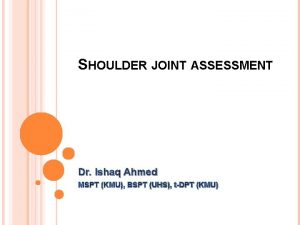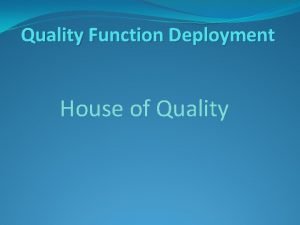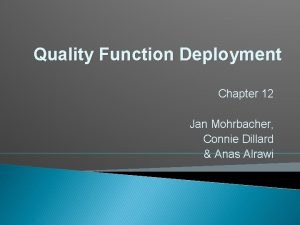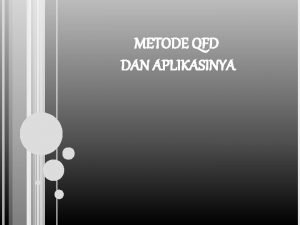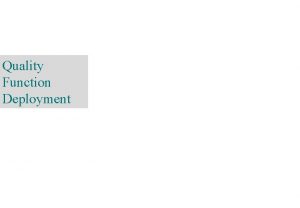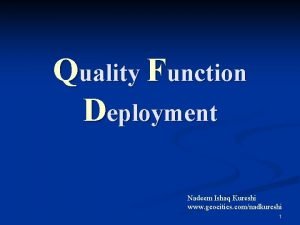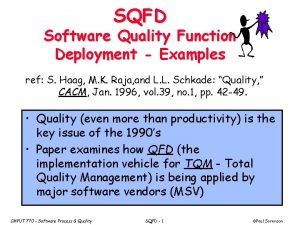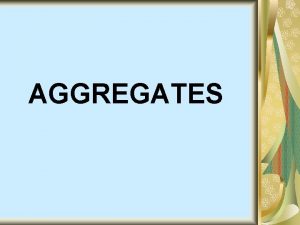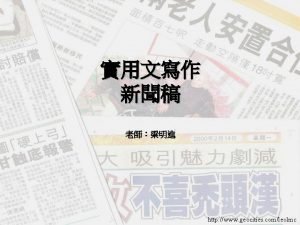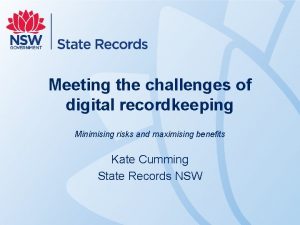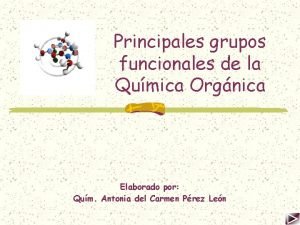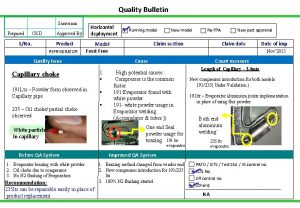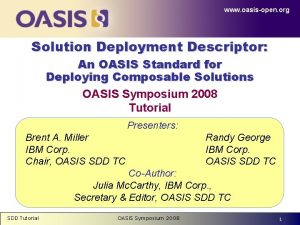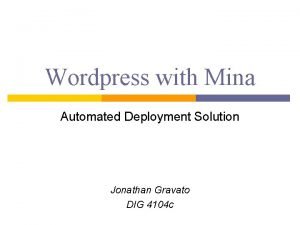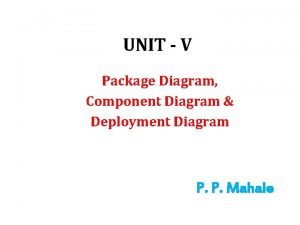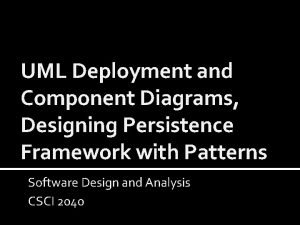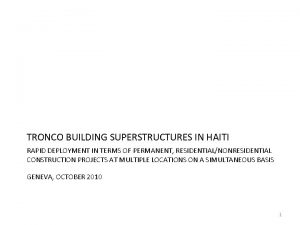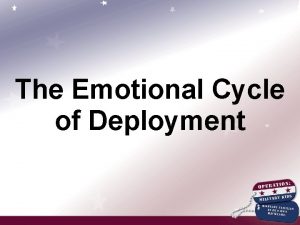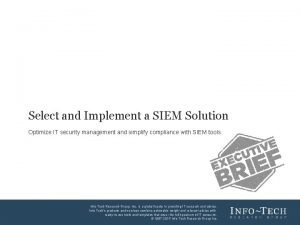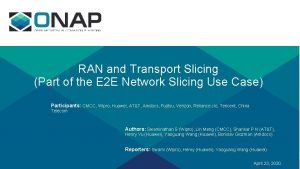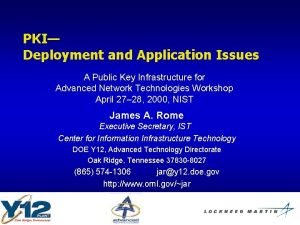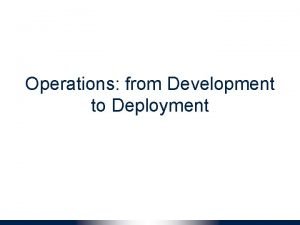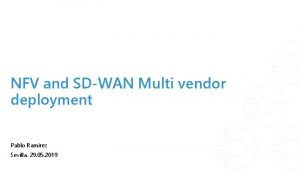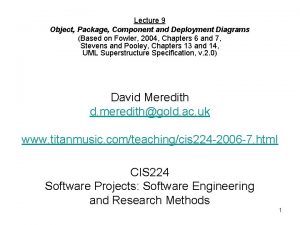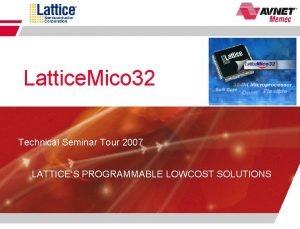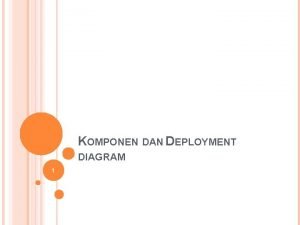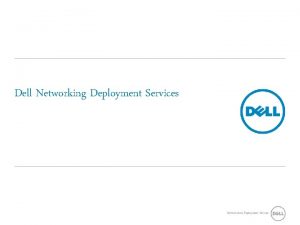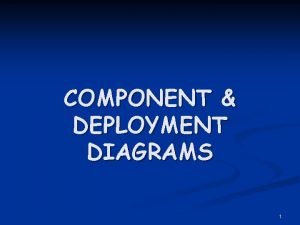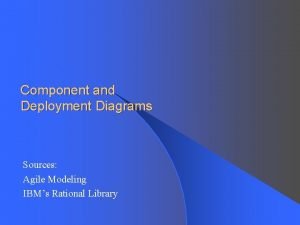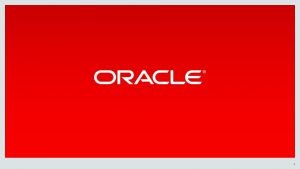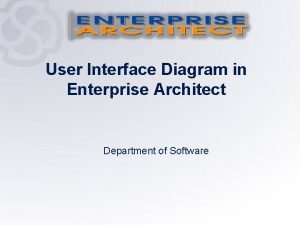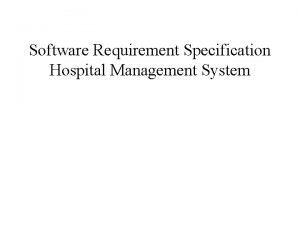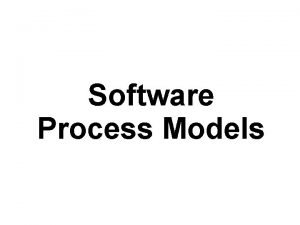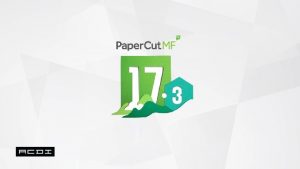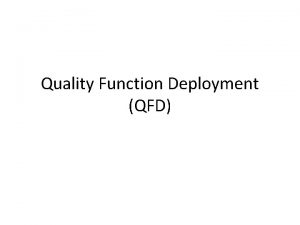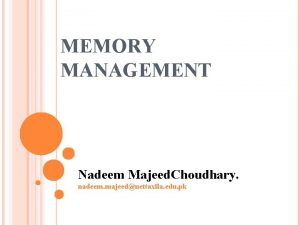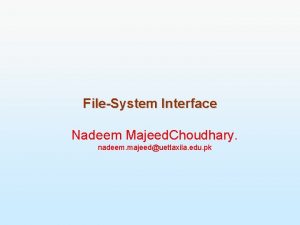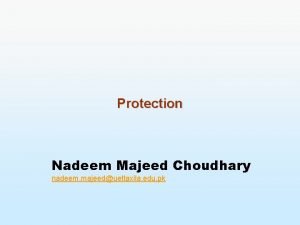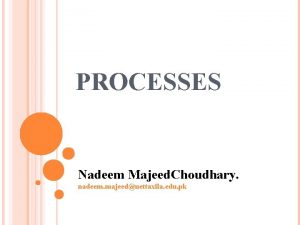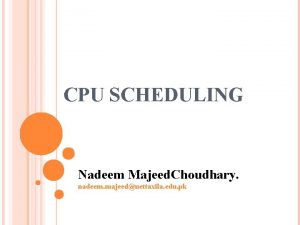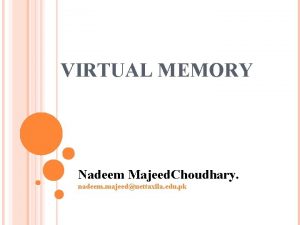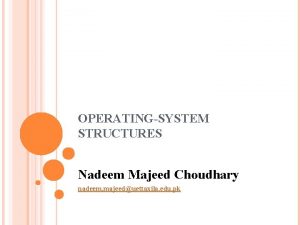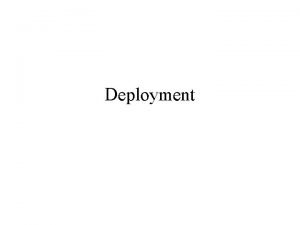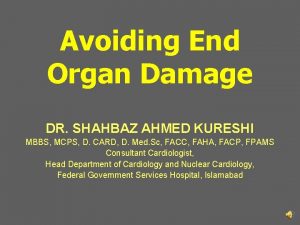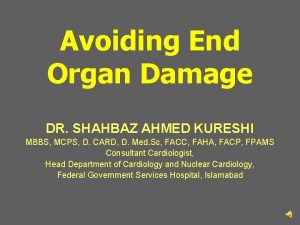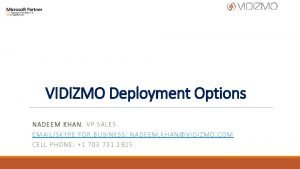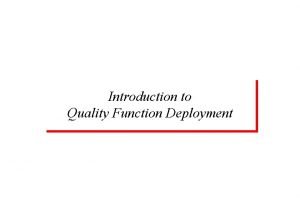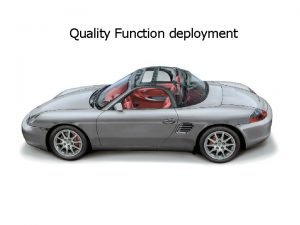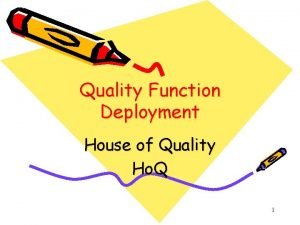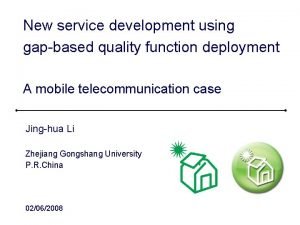Quality Function Deployment Nadeem Ishaq Kureshi www geocities






















































- Slides: 54

Quality Function Deployment Nadeem Ishaq Kureshi www. geocities. com/nadkureshi 1

Plan Overview n QFD: Step by Step n Interactive Tutorial n Case Study n Exercise n All material available at www. geocities. com/nadkureshi 2

Requirement Engineering (RE) n Engineering / Analysis of the requirements of a product or service lifecycle. n Conception, Design, Make, Deliver, Maintenance, Recycling …. . 3

Requirements n Customer Requirements n n n n Operational distribution or deployment: Where will the system be used? Mission profile or scenario: How will the system accomplish its mission objective? Performance and related parameters: What are the critical system parameters to accomplish the mission? Utilization environments: How are the various system components to be used? Effectiveness requirements: How effective or efficient must the system be in performing its mission? Operational life cycle: How long will the system be in use by the user? Environment: What environments will the system be expected to operate in an effective manner? 4

n Functional Requirements n n Performance Requirements n n Explain what has to be done, and identified The necessary task, action or activity that must be accomplished. Extent to which a mission or function must be executed; measured in terms of quantity, quality, coverage, timeliness or readiness Design Requirements n The “build to, ” “code to, ” and “buy to” requirements for products and “how to execute” requirements 5

n Derived Requirements n n Requirements that are implied or transformed from higher-level requirement. Allocated Requirements n Established by dividing / allocating a high-level requirement into multiple lower-level requirements. n Example: A 100 -pound item that consists of two subsystems might result in weight requirements of 70 pounds and 30 pounds for the two lower-level items. 6

Overview of QFD n The History of QFD. What is QFD? n Why use QFD? n Characteristics of QFD? n 7

History of QFD 1960’s, Yoji Akao conceptualized QFD. n Statistical Quality Control, SQC, was the central quality control activity after WWII. n SQC became Total Quality Control, TQC. n QFD was derived from TQC. n 8

First Application of QFD 1966, Bridgestone Tire Corp first used a process assurance table. n 1972, the process assurance table was retooled by Akao to include QFD process. n 1972, Kobe Shipyards (of Mitsubishi Heavy Industry) began a QFD Oil Tanker project. n 1978, Kobe Shipyards published their quality chart for the tanker. n 9

QFD Takes Hold The first paper on QFD was published in 1972. n In 1978, the first book on QFD was published in Japanese. n In 1983, the first English QFD article was published in North America. n By the late 1970’s most of the Japanese manufacturing industry were using QFD. n 10

QFD in North America n n QFD spread rapidly in North America during the 1980’s The Automobile industry and Manufacturing began heavy use of QFD at this time. QFD symposiums (North American, Japanese, European, International) were set up to explore research relating to QFD techniques. The QFD institute was formed in 1994. 11

Additional Techniques n There are many techniques which are a style of QFD or are used to enhance QFD. n These include: TRIZ, conjoint analysis, the seven product planning tools, Taguchi methods, Kano model, SQFD, DQFD, Gemba, Kaizen, Comprehensive QFD, QFD (N), QFD (B). 12

Overview of QFD n The History of QFD. n What is QFD? Why use QFD? n Characteristics of QFD? n 13

What is QFD? n Quality Function Deployment, QFD, is a quality technique which evaluates the ideas of key stakeholders to produce a product which better addresses the customers needs. n Customer requirements are gathered into a visual document which is evaluated and remodeled during construction so the important requirements stand out as the end result. 14

The QFD Paradigm n n n QFD provides the opportunity to make sure you have a good product before you try to design and implement it. It is about planning and problem prevention, not problem solving (Eureka, 1988). QFD provides a systematic approach to identify which requirements are a priority for whom, when to implement them, and why. 15

High-Level QFD n n n Requirements are initially elicited using other RE techniques (interviewing, brain-storming, focusgroups, etc). QFD involves the refinement of requirements using matrices and charts based on group decided priorities. There are 4 Phases of QFD. Each Phase requires internal iteration before proceeding to the next. Once at a Phase you do not go back. 16

What Does QFD Require? n n QFD requires time, effort, and patience. QFD requires access to stakeholder groups. The benefits of QFD are not realized immediately. Usually not until later in the project or the next project. QFD requires full management support. Priorities for the QFD process cannot change if benefits are to be realized. 17

Overview of QFD The History of QFD. n What is QFD? n n Why use QFD? n Characteristics of QFD? 18

Why use QFD? The QFD process leads participants to a common understanding of project direction and goals. n QFD forces organizations to interact across their functional boundaries (Hales, 1995). n QFD reduces design changes (Mazur, 2000). n 19

20

QFD Artifacts n n n Prioritized list of customers and competitors. Prioritized list of customer requirements. Prioritized list of how to satisfy the requirements. A list of design tradeoffs and an indication of how to compromise and weigh them. A realistic set of target values to ensure satisfaction. 21

What about Cost? Cost reduction is not mentioned as a ‘Why to use QFD’. n Initial costs will be as high or a little higher compared with traditional techniques. n You are seeking long term savings in that product or the products that follow. n 22

Overview of QFD The History of QFD. n What is QFD? n Why use QFD? n n Characteristics of QFD? 23

Characteristics of QFD n 4 Main Phases to QFD Product Planning including the ‘House of Quality’ (Requirements Engineering Life Cycle) n Product Design (Design Life Cycle) n Process Planning (Implementation Life Cycle) n Process Control (Testing Life Cycle) n 24

QFD Phase 1 is where most of the information is gathered. n Getting good data is critical. Any mistakes in requirements here will be magnified later. n Engineers should spend most of time in this Phase. n 25

The House of Quality (Ho. Q) n n n Is a set of matrices which contains the requirements (What’s) and the detailed information to achieve those requirements (How’s, How Much’s). Stakeholder groups fill in the matrices based on their priorities and goals. A key to the Ho. Q is making sure each group answers the same question about the same relationship, What vs How, cell. 26

Key Items to Address in Ho. Q n n n n n QFD Team Mission Statement. Who is the customer? What are the Requirements? How important is each requirement? How will you achieve each requirement? Complete the Relationship Matrix (what’s vs how’s). Which how’s are the most important? What are the tradeoffs between the how’s? What target values should be established? 27

QFD: Step by Step Guide How QFD Works n Step by Step Guide to Build a “House of Quality” n Example: n n Web page development 28

How QFD Works n n n Customer-requirements-driven design and production planning process Rationale is that product quality is measured by customer satisfaction and customers are satisfied if their needs or requirements are met QFD is building requirements into products. Inputs customer requirements Outputs production procedures for producing a product to satisfy customers. 29

How QFD Works (2) Technical Specificat ions Requirem ents Conceiv e Design High Level Design Process Metho ds Tools Producti on Procedure s QFD Planning Process 30

Customer Requirements n "Voice of Customer” (VOC) n n n Are “whats” Expressed in customer’s own language Qualitative, vague, ambiguous, incomplete, inconsistent Group session Categorization and organization 31

Technical Specifications n n n Voice of the Engineers or Designers (“hows”). Interpretations of "whats" in terms of technical specifications or design requirements (designers’ language) Potential choices for product features Each "whats" item must be converted (refined) to “how(s)” They have to be actionable (quantifiable or measurable) Free of technology and implementation creates flexibility for design 32

Relationship Matrix n n n “Whats” vs. “Hows” Correlates how “hows” satisfy “whats” Use symbolic notation for depicting weak, medium, and strong relationships A weight of 1 -3 -9 or 1 -3 -5 is often used More “strongs” are ideal Cross-checking ability 33

Customer Prioritization n n Prioritizing the importance of each “whats” item to the customer. Rate each “whats” item in 1 to 5 rating Completed by the customer AHP can be used 34

Customer Market Competitive Evaluations n n n Comparison of the developer's product with the competitor’s products Question: “Why the product is needed? ” The customer evaluates all products comparing each “whats” item Rating of 1 of 5 is given The results help position the product on the market. Identify the gaps 35

Target Goals n n n n “How much’s" of the “Hows“ (measurement) Answers a common design question: "How much is good enough (to satisfy the customer)? “ Not known at the time when the "hows" are determined. They are determined through analysis. Clearly stated in a measurable way as to how customer requirements are met Provides designers with specific technical guidance Can be used for (acceptance) testing. 36

Correlation Matrix n n n “Roof” part Identifies how “hows” items support (positive) or conflict (negative) with one another May combine strong positive items to reduce development effort Find trade-offs for negative items by adjusting “how much” values. Trade-offs must be resolved or customer requirements won’t be fully satisfied. 37

Technical Specifications Competitive Evaluation Similar to customer market competitive evaluations but conducted by the technical team n Technical advantages or disadvantages over competitor products n Conflicts may be found between customer evaluations and technical team evaluations n 38

Technical Difficulty Assessment Performed by technical teams n Helps to establish the feasibility and realization of each "hows" item n 1 to 5 ratings n 39

Overall Importance Ratings Only time when math is required n Calculated overall ratings n Function of relationship ratings and customer prioritization ratings. n Used to determine a set of technical specifications / requirements needed for the next phase. n 40

Decisions for Phase 2 n The “Hows” are analyzed Overall importance ratings n Technical difficulties n Competitive ratings n Decisions on design requirements are made n Start product design phase n 41

Interactive Tutorial n Acknowledgement n Macquarie Grad School of Mgt, Australia. Uses Flash Player n Can be viewed in Firefox or other explorers with required plug-ins n 42

CASE STUDY n APPLICATION OF QFD TO DSIGN A COURSE IN TQM AT Uo. M (COE) 43

DISCUSSION - CASE STUDY n APPLICATION OF QFD TO DSIGN A COURSE IN TQM AT Uo. M (COE) 44

EXERCISE n MAKE A QFD FOR AN ELECTRIC IRON 45

Importance House of Quality 5 Trade-off matrix 3 Design characteristics 1 4 2 Customer requirements Relationship matrix Competitive assessment 6 Target values 46

Competitive Assessment of Customer Requirements Easy and safe to use Irons well Competitive Assessment Customer Requirements Presses quickly 1 9 Removes wrinkles Doesn’t stick to fabric Provides enough steam Doesn’t spot fabric Doesn’t scorch fabric Heats quickly Automatic shut-off Quick cool-down Doesn’t break when dropped Doesn’t burn when touched Not too heavy 8 6 9 6 3 3 5 5 8 2 B A 3 4 5 X AB X X BA AB X AB A XB X A ABX X AB AB X X A B 47

Easy and safe to use Irons well Presses quickly Removes wrinkles Doesn’t stick to fabric Provides enough steam Doesn’t spot fabric Doesn’t scorch fabric Heats quickly Automatic shut-off Quick cool-down Doesn’t break when dropped Doesn’t burn when touched Not too heavy - - + + - Automatic shutoff Protective cover for soleplate Time to go from 450º to 100º Time required to reach 450º F Flow of water from holes Size of holes Number of holes Material used in soleplate Thickness of soleplate Size of soleplate Weight of iron Energy needed to press From Customer Requirements to Design Characteristics Customer Requirements - + + + + - - + + + - - + + + - - - + + + 48

Automatic shutoff Protective cover for soleplate Time to go from 450º to 100º Time required to reach 450º + Flow of water from holes - Size of holes Number of holes Material used in soleplate - Thickness of soleplate Size of soleplate Weight of iron Energy needed to press Tradeoff Matrix + + 49

Number of holes in. cm ty ea 3 1. 4 8 x 4 2 SS 27 15 0. 5 45 500 N Y 4 1. 2 8 x 4 1 MG 27 15 0. 3 35 350 N Y 2 1. 7 9 x 5 4 T 35 15 0. 7 50 600 N Y 3 4 4 4 5 4 3 2 5 5 3 0 3 3 4 3 3 3 4 4 5 2 1. 2 8 x 5 3 SS 30 30 500 * * * * Automatic shutoff Material used in soleplate Protective cover for soleplate Thickness of soleplate Time to go from 450º to 100º Size of soleplate lb Flow of water from holes Weight of iron ft-lb Size of holes Energy needed to press Objective measures Units of measure Iron A Iron B Our Iron (X) Estimated impact Estimated cost Targets Design changes Time required to reach 450º Targeted Changes in Design mm oz/s sec Y/N 50

Completed House of Quality SS = Silverstone MG = Mirorrglide T = Titanium 51

A Series of Connected QFD Houses Part characteristics Process characteristics A-2 Parts deployment A-3 Process planning Operations Process characteristics House of quality Part characteristics A-1 Product characteristics Customer requirements Product characteristics A-4 Operating requirements 52

DISCUSSION 53

Some URLs for QFD n http: //www. npd-solutions. com/qfdsteps. htm http: //www. qfdi. org/ http: //www. iti-oh. com/cppd/qfd_basics. htm n http: //www. becker-associates. com/qfdwhatis. htm n http: //www. pardee-quality-methods. com/qfdis. html http: //www. npd-solutions. com/qfd. html http: //www. icqfd. org/ n n 54
 Prophet ishaq family tree
Prophet ishaq family tree Acromioclavi
Acromioclavi Sunset red
Sunset red Quality function deployment
Quality function deployment Who conceptualized quality function deployment?
Who conceptualized quality function deployment? Metode quality function deployment
Metode quality function deployment Benefits of qfd
Benefits of qfd Quality function deployment
Quality function deployment Sqfd
Sqfd Are inert materials such as sand and gravel
Are inert materials such as sand and gravel Rana nadeem
Rana nadeem Www.geocities.com
Www.geocities.com Geocities page builder
Geocities page builder Geocities
Geocities Halogenuros de alquilo ejercicios resueltos
Halogenuros de alquilo ejercicios resueltos What is horizontal deployment
What is horizontal deployment Perform quality assurance
Perform quality assurance Plan quality management pmp
Plan quality management pmp Pmp gold plating
Pmp gold plating Define seminar in nursing management
Define seminar in nursing management Quality improvement vs quality assurance
Quality improvement vs quality assurance Basic concept of quality control and quality assurance pdf
Basic concept of quality control and quality assurance pdf Which of the gurus would be the father of quality control?
Which of the gurus would be the father of quality control? Quality is free
Quality is free What is tqm
What is tqm Deployment descriptor
Deployment descriptor Wordpress deployment automation
Wordpress deployment automation Common modeling techniques of deployment diagram
Common modeling techniques of deployment diagram Difference between component and deployment diagram
Difference between component and deployment diagram Tronco system
Tronco system Deployment cycle of emotions
Deployment cycle of emotions Serena deployment automation
Serena deployment automation Siem
Siem Greenfield vs brownfield deployment
Greenfield vs brownfield deployment Policy deployment
Policy deployment Lab 14-9 work with pki
Lab 14-9 work with pki Contoh deployment diagram
Contoh deployment diagram Development vs deployment
Development vs deployment Adva cpe
Adva cpe Imvu continuous deployment
Imvu continuous deployment Sales force specialization
Sales force specialization Deployment diagram vs component diagram
Deployment diagram vs component diagram Lattice mico
Lattice mico Komponen diagram
Komponen diagram Express deployment
Express deployment Power bi governance and deployment
Power bi governance and deployment Dell deployment services
Dell deployment services Component in deployment diagram
Component in deployment diagram Component diagram example
Component diagram example Altiris deployment server
Altiris deployment server Oracle maximum availability architecture deployment
Oracle maximum availability architecture deployment Interface design diagram
Interface design diagram Feasibility study of hospital management system project
Feasibility study of hospital management system project A generic process framework for software engineering
A generic process framework for software engineering Mobility print deployment
Mobility print deployment

